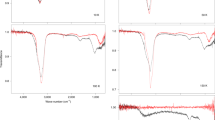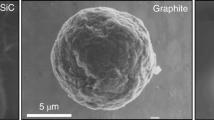Abstract
This review examines to what degrees the present chemical equilibrium condensation models are effective in predicting chemical composition of grains observed in a variety of cosmic environments. The composition expected from the equilibrium calculations is reviewed separately for refractory (rocky and metallic) and volatile (icy) components. Comments are given on the limitation of the equilibrium calculations in predicting the grain composition. By taking cometary ice as a typical cosmic volatile condensate, it is pointed out that its composition is far from that expected from the equilibrium models. Theories on the formation of cometary volatiles are reviewed, and an observational clue helpful to testing the theories is pointed out. Discussion is given on the advantage for formation of organic materials from volatile solids.
Access this chapter
Tax calculation will be finalised at checkout
Purchases are for personal use only
Preview
Unable to display preview. Download preview PDF.
Similar content being viewed by others
References
Amari, S., Anders, E., Virag, A, and Zinner, E. (1990): ‘Interstellar graphite in meteorites’, Nature 345, 238–240.
Bernatowicz, T., Fraundorf, G., Ming, T., Anders, E., Wopenka, B., Zinner, E., and Fraun-dorf, P. (1987): ‘Evidence for interstellar SiC in the Murray carbonaceous meteorites’, Nature 330, 723–728.
Bradley, J.P. and Brownlee, D.E. (1986): ‘Cometary particles: Thin sectioning and electron beam analysis’, Science 231, 1542–1544.
Bode, M.F. (1988): ‘Observations and modelling of circumstellar dust’, Dust in the Universe, eds. M.E. Bailey and D.A. Williams, Cambridge University Press, Cambridge, pp. 73–102.
d’Hendecourt, L.B., Allamandola, L.J., and Greenberg, J.M. (1985): ‘Time dependent chemistry in dense molecular clouds I. Grain surface reactions, gas/grain interactions and infrared spectroscopy’, Astron. Astrophys. 152, 130–150.
Duley, W.W. (1988): ‘Models of interstellar grains’, Dust in the Universe, eds. M.E. Bailey and D.A. Williams, Cambridge University Press, Cambridge, pp. 209–218.
Engel, S., Lunine, J.I., and Lewis, J.S. (1990):’ Solar nebula origin for volatiles in Halley’s comet’, Icarus 85, 380–393.
Fegley, B., Jr., and Prinn, R.G. (1989): ‘Solar nebula chemistry: Implications for volatiles in the solar nebula’, The Formation and Evolution of Planetary Systems, eds. H.A. Weaver, and L. Danley, Cambridge Univ. Press., Cambridge, pp. 171–211.
Gilman, R.C. (1969): ‘On the composition of circumstellar grains’, Astrophys. J 155, L185–L187.
Grossman, L. and Larimer, J.W. (1974): ‘Early chemical history of the solar system’, Rev. Geophys. Space Phys. 42, 71–101.
Greenberg, J.M. (1971): ‘The chemical and physical properties of interstellar dust’, Molecules in the Galactic Environment, eds. M.A. Gordon and L.E. Snyder, John Wiley &. Sons, New York, pp. 94–124.
Greenberg, J.M. (1982): ‘What are comets made of? A model based on interstellar dust’, Comets, ed. L.L. Wilkening, Univ. Arizona Press, Tucson, pp. 131–163.
Greenberg, J.M. (1988): ‘The interstellar dust model of comets: post Halley’, Dust in the Universe, eds. M.E. Bailey and D.A. Williams, Cambridge University Press, Cambridge, pp. 121–143.
Irvine, W.M. and Hjarmarson, Å. (1983): ‘Comets, interstellar molecules, and the origin of life’, Cosmochemistry and the Origin of Life, eds. C. Ponnamperuma, D. Reidel, Dordrecht, pp. 113–142.
Klinger, J. (1990), ‘Physical properties of frozen volatiles — Their relevance to the study of comet nuclei’, ‘Comets in the Post-Halley Era’, eds. R. Newburn and J. Rahe, Kluwer Academic Publishers, in press.
Kissel, J and Krüger, F.R. (1987): ‘The organic component in dust from Comet Halley as measured by the PUMA mass spectrometer on board Vega’ Nature 326, 755–760.
Kouchi, A. and Kuroda, T. (1990): ‘Amorphization of cubic ice by ultraviolet radiation’, Nature 344, 134–135.
Larson, H.P., Weaver, H.A., Mumma, M.J., and Drapatz, S. (1988): ‘Airborne infrared spec-troscopy of Comet Wilson (19861) and comparison with Comet Halley’, Astrophys. J. 338, 1106–1114.
Lewis, J.S. (1974): ‘The temperature gradient in the solar nebula’, Science 186, 440–443.
Lewis, J.S., and Prinn, R.G. (1980): ‘Kinetic inhibition of CO and N2 reduction in the solar nebula’, Astrophys. J. 238, 357–364.
Léger, A. and Puget, J.L. (1984): ‘Identification of the ‘unidentified’ IR emission features of interstellar dust?’, Astron. Astrophys. 137, L5–L8.
Lunine, J.I. (1989): ‘Primitive bodies: Molecular abundances in Comet Halley as probes of cometary formation environment’, The Formation and Evolution of Planetary Systems, eds. H.A. Weaver, L. Danley, and F. Paresce, Cambridge Univ. Press., Cambridge, pp. 213–242.
Mumma, M.J., Weaver, H.A., and Larson, H.P. (1987): ‘The ortho-para ratio of water vapor in comet P/Halley’, Astron. Astrophys. 187, 419–424.
Prinn, R.G., and Fegley, B., Jr. (1989):’ Solar nebula chemistry: Origin of planetary, satellite, and cometary volatiles’, Origin and Evolution of Planetary and Satellite Atmospheres, eds. S. Atrea, J. Pollack, and M. Matthews, Univ. Arizona Press, Tucson, pp. 78–136.
Sakata, A., Wada, S., Tanabé, T., and Onaka, T. (1984): ‘Infrared spectrum of the laboratory-synthesized quenched carbonaceous composite (QCC): Comparison with the infrared unidentified emission bands’, Astrophysical J. Lett. 287, L51–L54.
Salpeter, E.E. (1977): ‘Formation and destruction of dust grains’, Ann. Rev. Astron. Astrophys. 15, 267–293.
Seki, J. and Hasegawa, H. (1981): ‘Origin of amorphous interstellar ice grains’, Prog. Theor. Phys. 66, 903–912.
Weaver, H.A. (1989): ‘The volatile composition of comets’, Highlights Astron. 8, 387–393.
Whittet, D.C.B. (1984): ‘Interstellar grain composition: A model based on elemental depletions’, Mon. Not. R. Astron. Soc. 210, 479–487.
Woolf, N.J. (1975): ‘Circumstellar dust’, Dusty Universe, eds. G.B. Field and A.G.W. Cameron, Neale Watson Academic Publications, Inc., New York, pp. 59–87.
Yamamoto, T. (1985): ‘Formation environment of cometary nuclei in the primordial solar nebula’, Astron. Astrophys. 142, 31–36.
Yamamoto, T. (1990a): ‘Chemical theories on the origin of comets’, ‘Comets in the Post-Halley Era’, eds. R. Newburn and J. Rahe, Kluwer Academic Publishers, in press.
Yamamoto, (1990b): ‘The origin of comets as viewed from the gaseous composition’, Primitive Solar Nebula and Origin of the Planets, eds. H. Oya, K. Nakazawa, and H. Mizutani, Terra Publishing Company, Tokyo, in press.
Yamamoto, T., Nakagawa, N., and Fukui, Y. (1983): ‘The chemical composition and thermal history of the ice of a cometary nucleus’, Astron. Astrophys. 122, 171–176.
Author information
Authors and Affiliations
Editor information
Editors and Affiliations
Rights and permissions
Copyright information
© 1991 Springer Science+Business Media Dordrecht
About this paper
Cite this paper
Yamamoto, T. (1991). Chemical Composition of Dust Expected from Condensation Models. In: Levasseur-Regourd, A.C., Hasegawa, H. (eds) Origin and Evolution of Interplanetary Dust. Astrophysics and Space Science Library, vol 173. Springer, Dordrecht. https://doi.org/10.1007/978-94-011-3640-2_85
Download citation
DOI: https://doi.org/10.1007/978-94-011-3640-2_85
Publisher Name: Springer, Dordrecht
Print ISBN: 978-94-010-5616-8
Online ISBN: 978-94-011-3640-2
eBook Packages: Springer Book Archive




